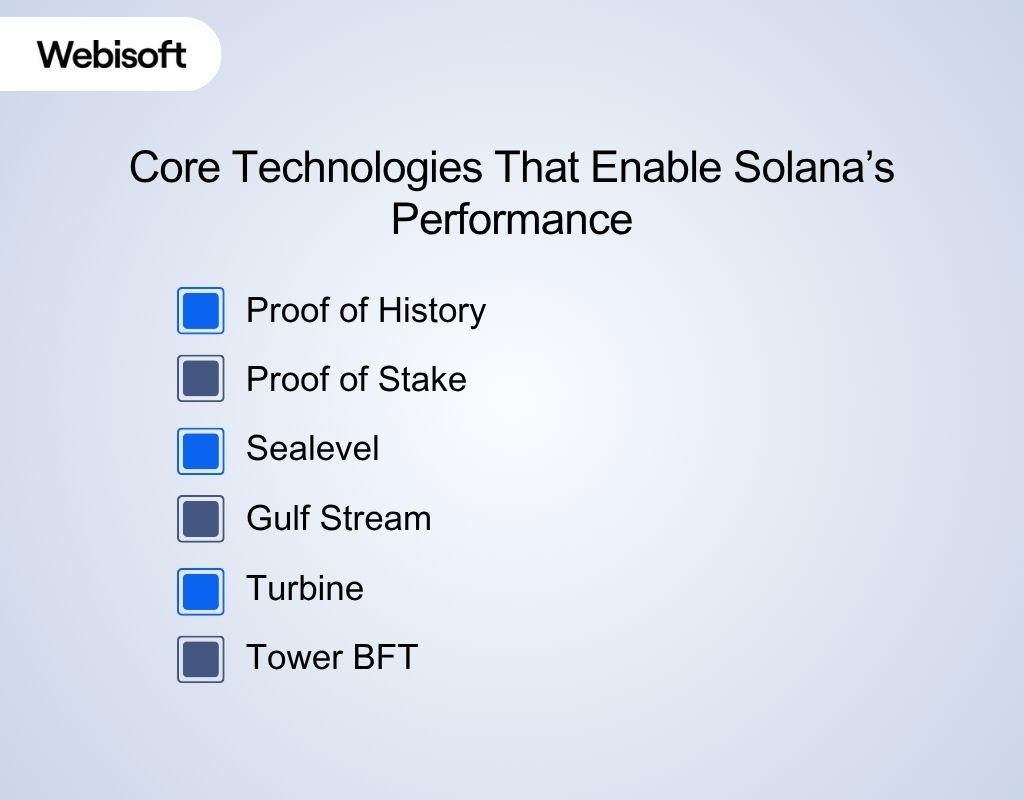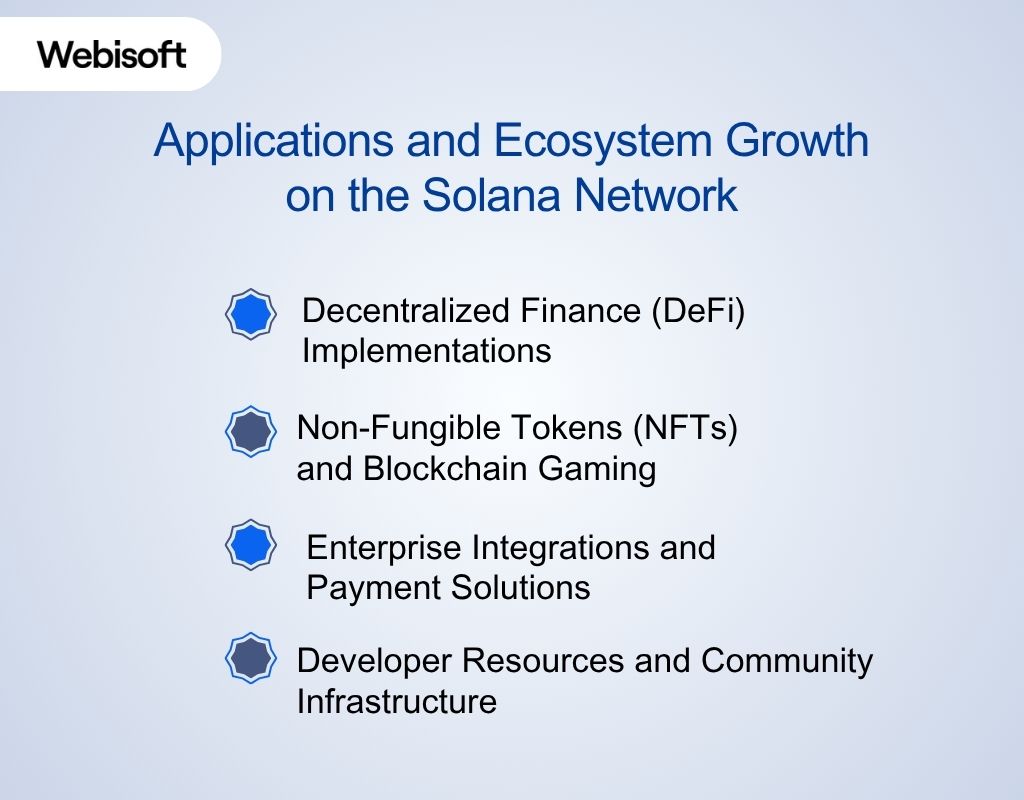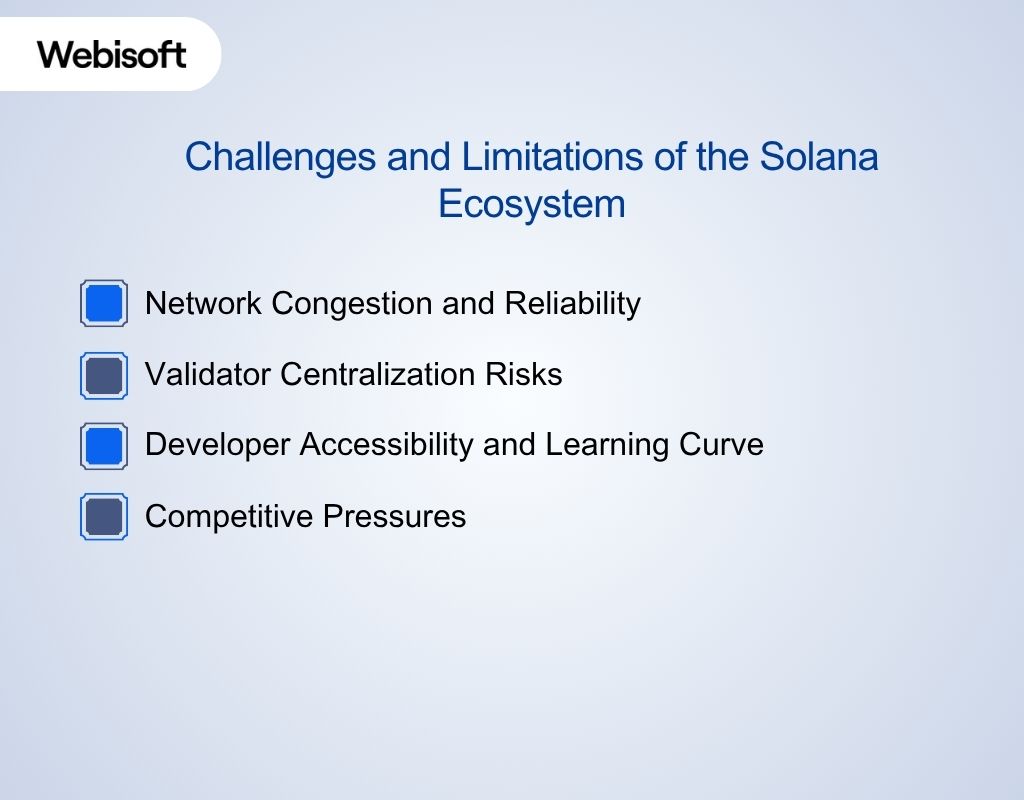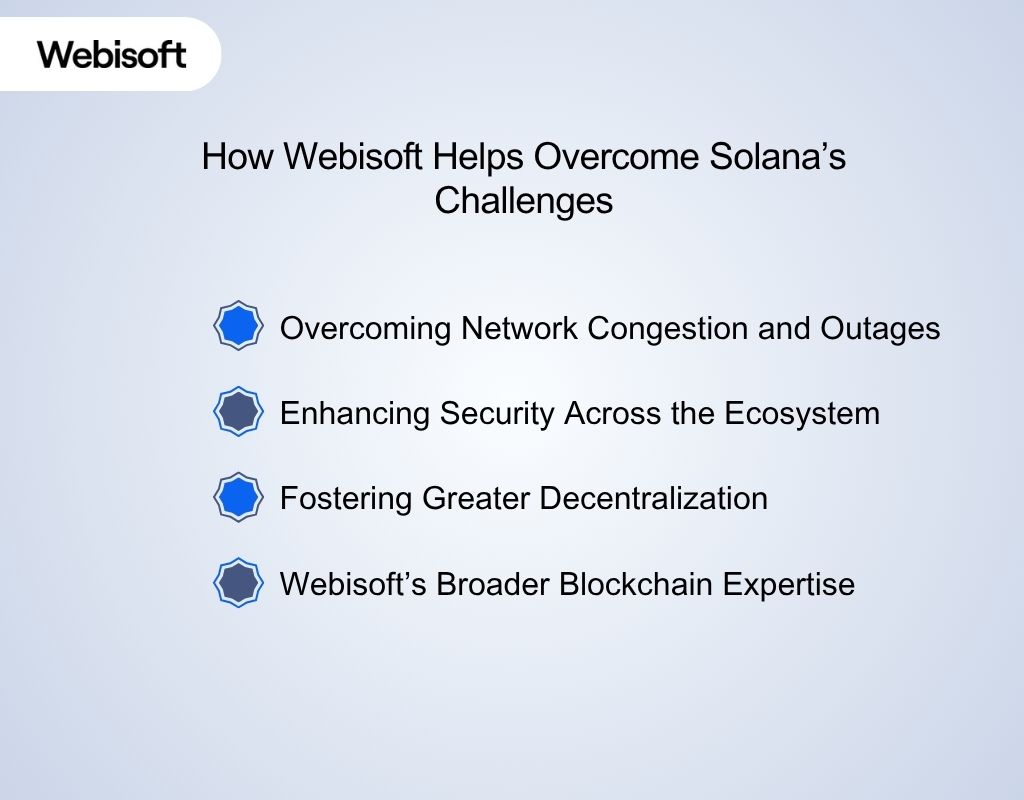How Does Solana Work: Understanding Its Blockchain Framework
- BLOG
- Blockchain
- November 9, 2025
In recent years, Solana has gained significant attention as one of the fastest and most efficient blockchain platforms in the industry. Designed to support high-performance decentralized applications, Solana has redefined what is possible in terms of transaction speed and scalability. Yet, many still ask a fundamental question: how does Solana work? Solana’s architecture was engineered to overcome the limitations of earlier blockchain systems. Such as Ethereum and Bitcoin, where network congestion often led to high fees and slow confirmation times. This article provides a structured overview of Solana’s technology, ecosystem, and operational model. It explains how its unique design enables thousands of transactions per second and supports a growing number of decentralized applications. Solana’s speed comes from how its core technologies work together. Each part solves a specific problem in blockchain performance, from time tracking to data delivery. These are the technologies behind Solana:
Solana’s speed comes from how its core technologies work together. Each part solves a specific problem in blockchain performance, from time tracking to data delivery. These are the technologies behind Solana: To understand how does Solana work, think of it as a system that runs on its own internal clock. I am going to break it down in this section but I should tell you that you can talk to us about your blockchain project if you need professional help. Let’s break down how that process unfolds from start to finish.
To understand how does Solana work, think of it as a system that runs on its own internal clock. I am going to break it down in this section but I should tell you that you can talk to us about your blockchain project if you need professional help. Let’s break down how that process unfolds from start to finish. Solana’s design overcomes the scalability limits of older systems, and its adoption shows that this approach works. The network supports a thriving ecosystem of projects spanning DeFi, NFTs, enterprise tools, and payments.
Solana’s design overcomes the scalability limits of older systems, and its adoption shows that this approach works. The network supports a thriving ecosystem of projects spanning DeFi, NFTs, enterprise tools, and payments. Without answering the limitations, understanding how does Solana work will not be possible. Solana’s speed and scalability have helped it rise quickly, but the network still faces several challenges. While recent improvements have strengthened its performance, some long-standing concerns remain. Understanding these issues is key to evaluating Solana’s long-term reliability and resilience.
Without answering the limitations, understanding how does Solana work will not be possible. Solana’s speed and scalability have helped it rise quickly, but the network still faces several challenges. While recent improvements have strengthened its performance, some long-standing concerns remain. Understanding these issues is key to evaluating Solana’s long-term reliability and resilience. Webisoft plays a key role in addressing these issues by combining technical expertise, enterprise-grade security, and Solana blockchain development experience. Our work focuses on enhancing stability, improving security, and supporting true decentralization within the Solana ecosystem.
Webisoft plays a key role in addressing these issues by combining technical expertise, enterprise-grade security, and Solana blockchain development experience. Our work focuses on enhancing stability, improving security, and supporting true decentralization within the Solana ecosystem.
Contents
- 1 What Is Solana (SOL)?
- 2 Core Technologies That Enable Solana’s Performance
- 3 Unlock the power of blockchain with Webisoft today!
- 4 How Does Solana Work?
- 5 Applications and Ecosystem Growth on the Solana Network
- 6 Challenges and Limitations of the Solana Ecosystem
- 7 How Webisoft Helps Overcome Solana’s Challenges
- 8 Unlock the power of blockchain with Webisoft today!
- 9 Conclusion
- 10 Frequently Asked Questions
What Is Solana (SOL)?
If you’ve heard people talk about Solana and wondered what makes it so fast, you’re not alone. Solana is a blockchain platform built for speed, scalability, and real-world use. It was created by Anatoly Yakovenko, a former engineer at Qualcomm who believed that blockchains could run as fast as the internet itself. His team launched Solana Labs in 2017, and today the network is governed by the Solana Foundation. At its core, Solana combines two powerful ideas: Proof of Stake (PoS) and Proof of History (PoH). PoS secures the network through validators who stake SOL, while PoH acts like a cryptographic clock that records the order of events. Together, these systems let the blockchain confirm and sequence Solana transactions in parallel, cutting out most of the waiting time you’d find on older networks. That design gives Solana its signature advantage: speed and affordability. The network can handle thousands of transactions per second with finality in under a second, and average fees cost less than a penny. In contrast, Ethereum still processes fewer than 15 TPS and usually costs much more per transaction.Core Technologies That Enable Solana’s Performance
 Solana’s speed comes from how its core technologies work together. Each part solves a specific problem in blockchain performance, from time tracking to data delivery. These are the technologies behind Solana:
Solana’s speed comes from how its core technologies work together. Each part solves a specific problem in blockchain performance, from time tracking to data delivery. These are the technologies behind Solana:Proof of History
Most blockchains depend on synchronized clocks or constant communication between nodes to agree on time. That causes delays. Solana uses Proof of History (PoH) as a built-in cryptographic clock. Solana’s Proof of History timestamps every event before consensus begins, reducing validator communication delays by nearly 80% compared to traditional Proof of Stake systems. According to the Solana Foundation Research page, this sequencing allows the network to maintain consistent throughput even during high-demand periods. It chains SHA-256 hashes one after another, with each hash linked to the previous one. Anyone can verify the exact order of events by checking that sequence. Validators do not need to coordinate timestamps, which helps the network reach consensus faster.Proof of Stake
Solana’s security comes from Proof of Stake (PoS). Validators stake SOL tokens to earn the right to produce and verify blocks. The system rewards honest behavior and discourages attacks by penalizing bad actors. Together, PoS and PoH make Solana efficient and eco-friendly. Instead of energy-heavy mining, transactions are confirmed through staking, keeping power use minimal. PoS ensures security and fairness while PoH maintains speed. Both work together to form Solana’s hybrid consensus model.Sealevel
Sealevel is Solana’s engine for parallel transaction execution. Unlike Ethereum, which processes transactions one by one, Sealevel identifies non-conflicting transactions and runs them at the same time. Each transaction declares which accounts it touches. This allows the network to safely run multiple smart contracts at once across available CPU cores. Parallel processing lets Solana handle large workloads, such as decentralized exchanges or blockchain games, without slowing down.Gulf Stream
Traditional networks use mempools, where unconfirmed transactions wait for inclusion in blocks. Solana removes this step with Gulf Stream, which forwards transactions directly to the next block producer. Since Solana knows future leaders ahead of time, it sends transactions straight to them. This eliminates congestion, lowers confirmation time, and keeps the network efficient. Gulf Stream prevents buildup of unprocessed transactions and helps Solana maintain fast confirmation speeds.Turbine
This plays a big role in answering how does Solana work. When a block is ready, it must reach validators quickly. Solana’s Turbine protocol handles that by splitting each block into small pieces called shreds. These shreds are shared within small groups of validators. Each group forwards them to others until the full network has received the data. Turbine also uses erasure coding and stake-weighted routing to maintain reliability even if some data is lost.Tower BFT
Solana finalizes blocks through Tower Byzantine Fault Tolerance (Tower BFT). This system builds on the PoH clock to coordinate validator votes automatically. Validators know exactly when to vote and confirm blocks without waiting for manual signals. This makes the process predictable and quick. Tower BFT provides deterministic finality, meaning transactions are verified within seconds and cannot be changed afterward.Unlock the power of blockchain with Webisoft today!
Book a free consultation. Learn, build, and scale secure Solana blockchain solutions effortlessly.
How Does Solana Work?
 To understand how does Solana work, think of it as a system that runs on its own internal clock. I am going to break it down in this section but I should tell you that you can talk to us about your blockchain project if you need professional help. Let’s break down how that process unfolds from start to finish.
To understand how does Solana work, think of it as a system that runs on its own internal clock. I am going to break it down in this section but I should tell you that you can talk to us about your blockchain project if you need professional help. Let’s break down how that process unfolds from start to finish.Cryptographic Timestamping
At the heart of PoH is cryptographic timestamping. It uses a sequential hash function that takes an input, such as the current blockchain state and a random seed, and produces a unique hash. This hash is irreversible, meaning it cannot be changed or recreated. Each hash acts as a timestamp that proves when an event happened on the network.Generating a Hash Chain
Solana builds a hash chain by feeding each new hash back into the function. Every hash links to the one before it, creating a continuous chain of time. Each iteration of this process represents a “tick.” The number of ticks reflects the passage of time, forming a verifiable timeline that sequences transactions in exact order.Recording Transactions
When you make a transaction, it attaches to the most recent hash in that chain. Validators check that the transaction references a valid and current hash within the ongoing PoH sequence. If it does, the transaction is recorded as having occurred at a specific, provable moment in Solana’s timeline.Verifiable Delay Function
Behind this system is the Verifiable Delay Function (VDF). It ensures that each hash is produced only after a measurable delay. A leader must compute one hash before moving to the next, and this process cannot be skipped or sped up. That rule guarantees that time in Solana moves forward in an exact, verifiable order. Each transaction connects to a precise point in the PoH chain, so validators instantly know when it happened compared to others.Consensus and Tower BFT
After transactions are timestamped, Solana’s Tower BFT consensus takes over. This system is based on Practical Byzantine Fault Tolerance (PBFT) but optimized for PoH’s internal clock. Validators stake SOL tokens and vote on which version of the ledger they support. Because each transaction already carries a timestamp, validators can verify order and confirm blocks much faster. The longer a validator’s vote stays on a block, the harder it becomes to change that decision. This process quickly locks in final, irreversible confirmations.Applications and Ecosystem Growth on the Solana Network
 Solana’s design overcomes the scalability limits of older systems, and its adoption shows that this approach works. The network supports a thriving ecosystem of projects spanning DeFi, NFTs, enterprise tools, and payments.
Solana’s design overcomes the scalability limits of older systems, and its adoption shows that this approach works. The network supports a thriving ecosystem of projects spanning DeFi, NFTs, enterprise tools, and payments.Decentralized Finance (DeFi) Implementations
Solana has become a major hub for decentralized finance. Its low fees and high speed make it ideal for platforms that handle many transactions at once. Projects like Raydium, Mango Markets, and Orca use Solana’s parallel processing to offer real-time trading and lending with minimal slippage. These platforms give users the ability to swap tokens, earn yield, and borrow assets without relying on intermediaries. For developers, Solana’s performance makes it easier to design scalable DeFi products that can handle market-level volume efficiently.Non-Fungible Tokens (NFTs) and Blockchain Gaming
Solana is also a favorite network for NFTs and Web3 gaming. Low transaction costs and instant finality make minting and trading NFTs smooth and affordable. Marketplaces such as Magic Eden and Tensor have helped onboard millions of users to digital art and gaming assets on Solana. On the gaming side, projects like Star Atlas and Aurory use Solana to power in-game economies and real asset ownership. Players can trade items, collectibles, and characters in real time without lag or high fees.Enterprise Integrations and Payment Solutions
Businesses are finding creative ways to use Solana for payments and identity systems. Kin, originally built for the Kik messaging app, now runs on Solana, enabling microtransactions at scale. Solana Pay allows merchants to accept crypto payments instantly while keeping fees near zero. These features make Solana attractive for retail, fintech, and loyalty-based platforms. Enterprise developers are also exploring Solana for digital identity. Solana ID, for instance, offers verifiable credentials and on-chain reputation systems that can bridge Web2 and Web3 user experiences.Developer Resources and Community Infrastructure
Behind Solana’s ecosystem is a large and active developer community. Thousands of builders contribute to open-source tools, libraries, and SDKs designed to make development faster. Resources like the Solana Developer Hub and Solana Foundation grants support education, hackathons, and startup funding for new projects. Platforms such as Audius, a decentralized music-streaming service, show how diverse applications can run on Solana’s architecture. The combination of developer-friendly tools, low costs, and active community support keeps the network growing at a rapid pace.Challenges and Limitations of the Solana Ecosystem
 Without answering the limitations, understanding how does Solana work will not be possible. Solana’s speed and scalability have helped it rise quickly, but the network still faces several challenges. While recent improvements have strengthened its performance, some long-standing concerns remain. Understanding these issues is key to evaluating Solana’s long-term reliability and resilience.
Without answering the limitations, understanding how does Solana work will not be possible. Solana’s speed and scalability have helped it rise quickly, but the network still faces several challenges. While recent improvements have strengthened its performance, some long-standing concerns remain. Understanding these issues is key to evaluating Solana’s long-term reliability and resilience.Network Congestion and Reliability
Solana has experienced occasional performance problems that tested user confidence. Outages in September 2021 and January 2022 slowed transaction processing and affected trading, DeFi activity, and NFT minting. These incidents exposed weaknesses in how validators handled heavy transaction loads. Since then, the Solana Foundation and development teams have worked to stabilize the network. The Firedancer project, developed by Jump Crypto, is a new validator client built to improve reliability and throughput. It aims to reduce dependence on a single software implementation and is expected to be fully deployed in 2025. Today, Solana has maintained a long stretch of uptime. Priority fees now help prevent congestion during high-traffic events like NFT launches or token sales. Even so, some users and developers still remember the network’s earlier instability, which keeps reliability an ongoing focus.Validator Centralization Risks
Another challenge is validator centralization. A large portion of SOL staking remains concentrated among a small group of validators. That concentration can limit decentralization and create potential risks during network stress, such as slower recovery or increased censorship exposure. To address this, the Solana Foundation supports stake pool programs and delegation initiatives that encourage stake distribution among smaller validators. Platforms like Marinade and Lido on Solana are helping to spread participation more evenly across the network.Developer Accessibility and Learning Curve
Unlike Ethereum, Solana does not use the Ethereum Virtual Machine (EVM). Developers must build using Rust or specialized SDKs, which presents an initial learning curve. This difference limited developer onboarding in Solana’s early years. Over time, the community and Solana Foundation have invested heavily in developer support. New frameworks, improved documentation, and frequent hackathons have attracted thousands of new contributors.Competitive Pressures
Solana operates in a highly competitive space. New blockchains such as Aptos and Sui, along with Ethereum Layer 2 networks like Arbitrum and Optimism, offer fast and low-cost alternatives. These platforms compete for liquidity, users, and developer talent. The growing popularity of cross-chain bridges and modular blockchain designs also makes it easier for users to move assets between ecosystems. This flexibility means Solana must continue improving user experience, developer incentives, and infrastructure to retain its position.How Webisoft Helps Overcome Solana’s Challenges
 Webisoft plays a key role in addressing these issues by combining technical expertise, enterprise-grade security, and Solana blockchain development experience. Our work focuses on enhancing stability, improving security, and supporting true decentralization within the Solana ecosystem.
Webisoft plays a key role in addressing these issues by combining technical expertise, enterprise-grade security, and Solana blockchain development experience. Our work focuses on enhancing stability, improving security, and supporting true decentralization within the Solana ecosystem.Overcoming Network Congestion and Outages
Solana’s early performance issues often stemmed from heavy traffic and automated bot activity. Webisoft helps projects deploy solutions that maintain network reliability even during peak usage. Our team implements critical protocol-level improvements such as the QUIC protocol, which enhances flow control and transaction delivery. We also integrate Stake-Weighted Quality of Service (SWQoS) to prioritize essential transactions and limit spam traffic. To manage localized congestion, we design systems that apply priority fee mechanisms and localized fee markets, ensuring faster transaction processing. Webisoft also provides validator optimization support, improving coordination and reducing downtime through advanced monitoring tools. As part of long-term resilience, we assist teams preparing for the integration of Firedancer, an alternative validator client that improves redundancy and reduces software dependency.Enhancing Security Across the Ecosystem
Security is one of Webisoft’s strongest areas of expertise. We follow rigorous auditing standards and adopt advanced security tools tailored for Solana’s architecture. Our developers use formal verification and third-party audits to identify vulnerabilities before deployment. We apply safe Rust coding practices like validated input handling, ownership checks, and controlled arithmetic operations. Frameworks such as Anchor and analysis tools like Sec3 are integrated into every project to detect and prevent vulnerabilities automatically. Webisoft also enforces supply chain security through dependency version pinning and cryptographic integrity verification to protect against malicious code. These practices ensure that every Solana-based application meets enterprise-grade security standards and maintains long-term trust.Fostering Greater Decentralization
A decentralized network depends on validator diversity and economic inclusivity. Webisoft actively supports Solana’s decentralization goals by empowering smaller participants and promoting fair network participation. We help validators join the Solana Foundation Delegation Program (SFDP) to gain staking support and improve network diversity. Our experts also design sustainable validator incentive models that balance cost and reward, encouraging healthy participation without centralizing power. To lower entry barriers, we provide hardware configuration guidance and optimized setups, helping new validators operate efficiently while maintaining system integrity. Through these steps, Webisoft contributes directly to building a more balanced, open, and distributed Solana validator ecosystem.Webisoft’s Broader Blockchain Expertise
Webisoft’s blockchain portfolio extends across every major development framework, giving us the flexibility to innovate beyond Solana. Our technical expertise covers: Scale your organization faster with Webisoft’s blockchain consulting services. Whether you’re integrating Solana or optimizing existing infrastructure, our experts deliver tailored strategies for secure, high-performance decentralized systems.Unlock the power of blockchain with Webisoft today!
Book a free consultation. Learn, build, and scale secure Solana blockchain solutions effortlessly.


